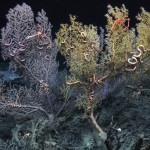
That’s right, new work suggests BP’s estimates of oil flowing from the broken well were an order of magnitude off. With these revised estimates, the BP Gulf Spill is 10 times the size of the Exxon Valdez spill. The new estimate calculates flow rate from the resolution of the plume in 30 second video grabs with a method called optical plume velocimetry technique (o’ yes I will be dropping that into conversation this weekend over cocktails). The faster the flow the lower the resolution of the plume in the video. Interestingly, this technique was developed to measure venting at hydrothermal vents. Love this quote from the press release
“This is a great example of how basic research that doesn’t seem to have any immediate value suddenly gains huge immediacy for society,” said study researcher Timothy Crone, a marine geophysicist at Columbia University, in a statement.






LMAO I was on the cruise in 2005 when these things were being tested! They look like frying pans with a grid overlaid on it. It was put in the hydrothermal vent plume and recorded for a certain period of time. The software basically finds a particle and follows it, then calculates how far it went based on the grid and the time it took to travel. Scale it up to gazillions of particles and you get a mean flow rate. Simple and elegant, yet another reason to keep funding hydrothermal vent science!
This is just the beginning. U really think this will work?